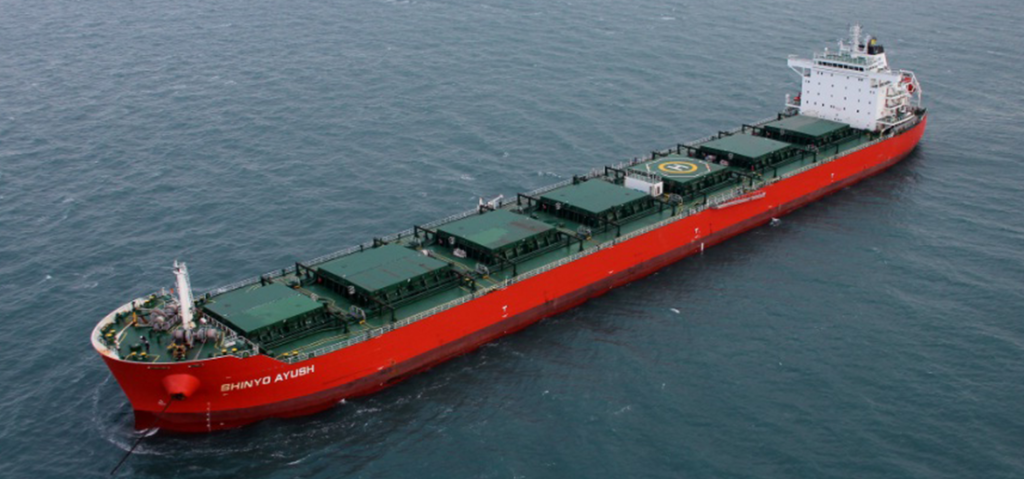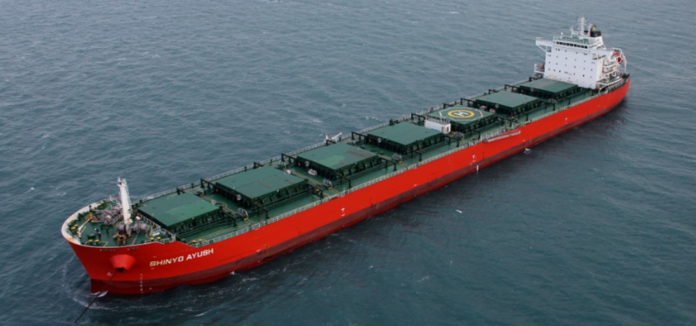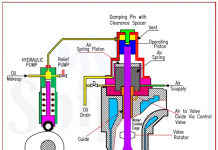
Definitions
1. “Bulk carrier” means the bulk carrier as defined in regulation IX/1.6. (Resolution 1 adopted by the 1994 SOLAS Conference)
Bulk carrier means the ship which is constructed generally with single deck, top-side tanks and hopper side tanks in cargo spaces, and is intended primarily to carry dry cargo in bulk, and includes such type as ore carriers & combination carriers.
2. “Bulk carrier of the single side skin construction” means the bulk carrier in which a cargo hold is bounded by the side shell.
3. “Length” of the bulk carrier means the length as defined in the International Convention on Load Lines in force.
4. Solid bulk cargo means the substance, other than the liquid or gas, comprises of the combination of particles, granules or any larger pieces of material, generally uniform in composition, which is loaded directly into the cargo spaces of the ship without any intermediate form of containment.
5. Bulk carrier bulkhead & double bottom(DB) strength standards means Standards which is required for the evaluation of scantlings of the transverse watertight vertically corrugated bulkhead between the two foremost cargo holds and for the assessment of the permissible loading of a foremost hold which is approved by resolution(4) of the Conference of Contracting Governments to the International Convention for the Safety of Life at Sea, 1974 on (27 November 1997) as may be modified by the Organization, provided that such amendments are adopted, brought into force and take effect in accordance with the provisions of article VIII of the present Convention regarding the amendment procedures applicable to the annex other than chapter I.
Application
Bulk carriers shall follow with the requirements of this chapter in addition to the applicable requirements of other chapters.
Implementation schedule
1. Bulk carriers which are 20 years of age & over on 1 July 1999, by the date of the first intermediate survey or the first periodical survey after 1 July 1999, whichever comes first;
2. Bulk carriers which are 15 years of age and over but less than 20 years of age on l July 1999, by the date of the first periodical survey after 1 July 1999, however not later than 1 July 2002; and
3. Bulk carriers which are less than the 15 years of age on 1 July 1999, by the date of the first periodical survey after the date on which the ship reaches 15 years of age, however, not later than the date on which the ship reaches 17 years of age.
Damage stability requirements applicable to bulk carriers
1. Bulk carriers of 150 m in length & above of single side skin construction, designed to carry solid bulk cargoes having a density of 1000 kg/m3 and above, constructed on or after 1 July 1999 shall, when loaded up to their summer load line, be able to withstand flooding of any one cargo hold in all loading conditions and remain afloat in a satisfactory condition of equilibrium.
2. Bulk carriers having length of 150 m & above of single side skin construction, carrying solid bulk cargoes having a density of 1780 kg/m3 and above, constructed before 1 July 1999 shall, when loaded up to their summer load line, be able to withstand flooding of the foremost cargo hold in all loading conditions and remain afloat in a satisfactory condition of equilibrium.
3. The permeability of the loaded hold shall be assumed as 0.9 and the permeability of an empty hold shall be assumed as 0.95.
Structural strength of bulk carriers
(This regulation applies to the bulk carriers constructed on or after 1 July 1999)
Bulk carriers of 150 m in length & above of single side skin construction, designed to carry solid bulk cargoes having a density of 1000 kg/m3 and above, shall have sufficient strength to withstand flooding of any one cargo hold in all loading and ballast conditions, taking also into account dynamic effects resulting from the presence of water in the hold, and taking into account the directions adopted by the Organization.
Structural and other requirements for bulk carriers
(This regulation applies to the bulk carriers constructed before 1 July 1999)
1. Bulk carriers of 150 m in length & above of single side skin construction, carrying solid bulk cargoes having a density of 1780 kg/m3 and above, shall comply with the requirements of this regulation in accordance with the implementation schedule.
2. The transverse watertight bulkhead between the two foremost cargo holds and the double bottom of the foremost cargo hold shall have sufficient strength to withstand flooding of the foremost cargo hold, considering dynamic effects resulting from the presence of water in the hold, in compliance with the Bulk carrier bulkhead and double bottom strength standards.
Survey of the cargo hold structure of the bulk carriers
(This regulation applies to the bulk carriers constructed before 1 July 1999)
A bulk carrier of 150 m in length & above of single side skin construction, of 10 years of age and over, shall not carry solid bulk cargoes having a density of 1780 kg/m3 & above unless it has satisfactorily undergone either:
1. A periodical survey according to the enhanced programme of inspections required by regulation XI/2; or
2. A survey of all cargo holds to the same extent as needed for the periodical surveys in the enhanced survey programme of inspections required by regulation XI/2.
Information on compliance with requirements for bulk carriers
1. Any limitation in force on the carriage of solid bulk cargoes having a density of 1780 kg/m3 and above in accordance with the requirements of regulation 6 shall be identified and recorded in the booklet.
2. A bulk carrier shall be continually marked on the side shell at three positions at amidships, port and starboard, with a solid equilateral triangle having sides of 500 mm and its apex 300 mm beneath the deck line, and painted a contrasting colour to that of the hull.
Requirements for bulk carriers not being capable of complying with regulation 4.2 due to the design configuration of their cargo holds
- Are provided with the bilge well high water level alarms in all cargo holds, or in the cargo conveyor tunnels, as appropriate, giving an audible and visual alarm on the navigation bridge, as endorsed by the Administration or an organization recognized by it.
- Are provided with the complete information on the particular cargo hold flooding scenarios. This instructions shall be followed by complete directive on the evacuation preparedness under the provisions of Section 8 of the International Safety Management (ISM) Code and be used as the basis for crew training and drills.
Solid bulk cargo density declaration
- carriage of the solid bulk cargoes having a density of 1780 kg/m3 or above, any cargo declared to have a density within the range 1250 kg/m3 to 1780 kg/m3 shall have its density endorsed by an accredited testing organization.
Loading Instrument
- Bulk carriers of 150 m in length & above shall be fitted with a loading instrument capable of providing information on hull girder shear forces and bending moments, taking into account the recommendation adopted by the Organization.
Water level detectors in cargo holds
Bulk carriers shall be fitted with the water level detectors in the aft end of each cargo hold, giving both audible and visual alarms on each occasion the water level above the inner bottom of cargo hold reaches:
(a) A height of 0.5 metres; and
(b) Whichever is the lower of either:
(i) The height of a point which is not less than(<) 15% of the depth of the cargo hold, or
(ii)A height of two metres.
Water level detectors in ballast tanks
- A water level detector shall be fitted in each forward ballast tank of a bulk carrier shall give both an audible and visual alarm when the liquid in the forward ballast tank reaches a level not exceeding 10% of tank capacity.
- A device which overrides the alarm be installed and activated when the forward ballast tank is in use.
Water level detectors in dry or void space
water level detector shall be fitted in each & every dry or void space of a bulk carrier, any part of which extends forward of the foremost cargo hold, giving an audible & visual alarm at a water depth of 0.1m in that space.
These alarms need not be fitted in the following areas:
(a) a dry/void space which is a chain cable locker; or
(b) in an enclosed space having volume which does not exceed 0.1% of the ship’s maximum displacement volume.
Disclaimer: Data in the article have been sourced from available information in the internet from different sources.




